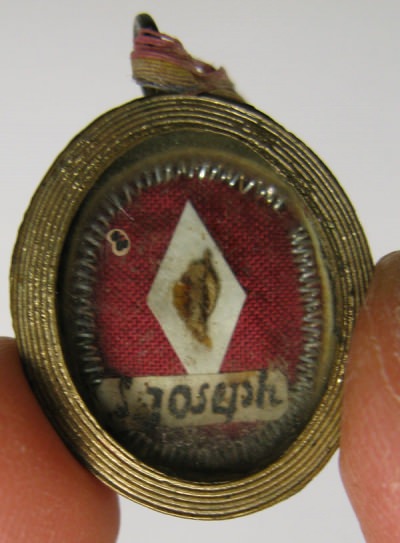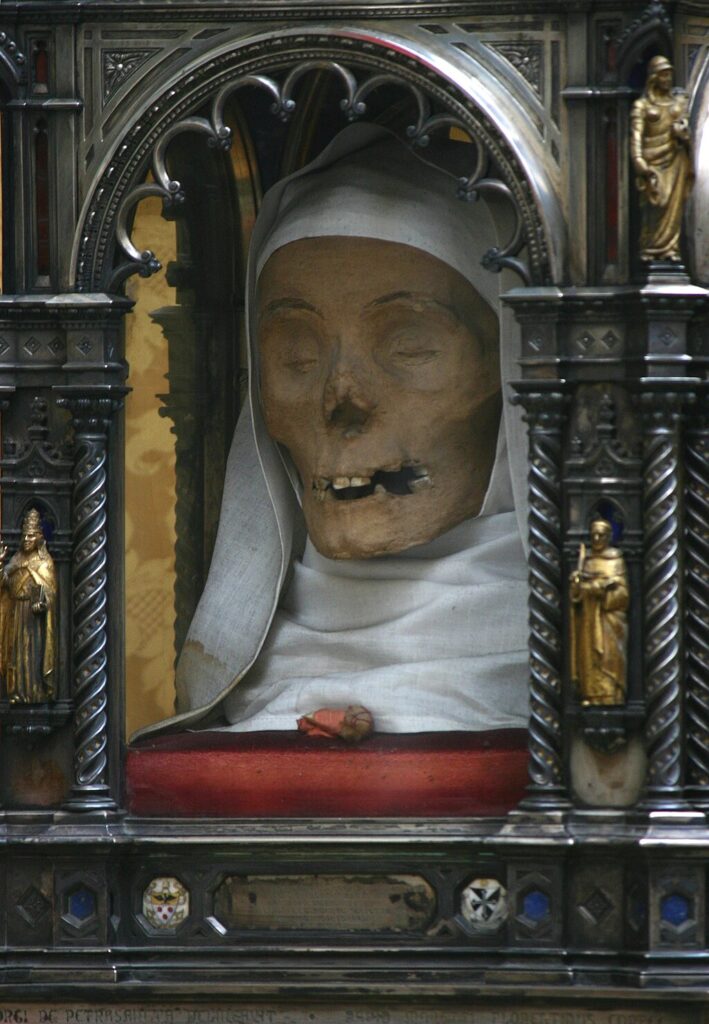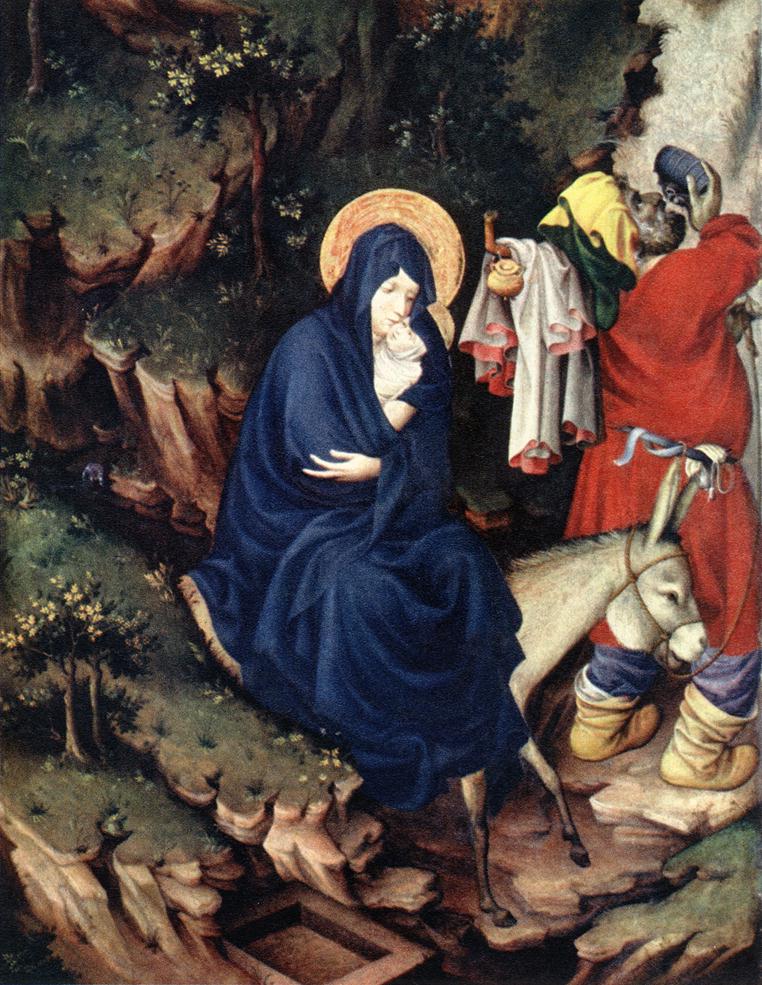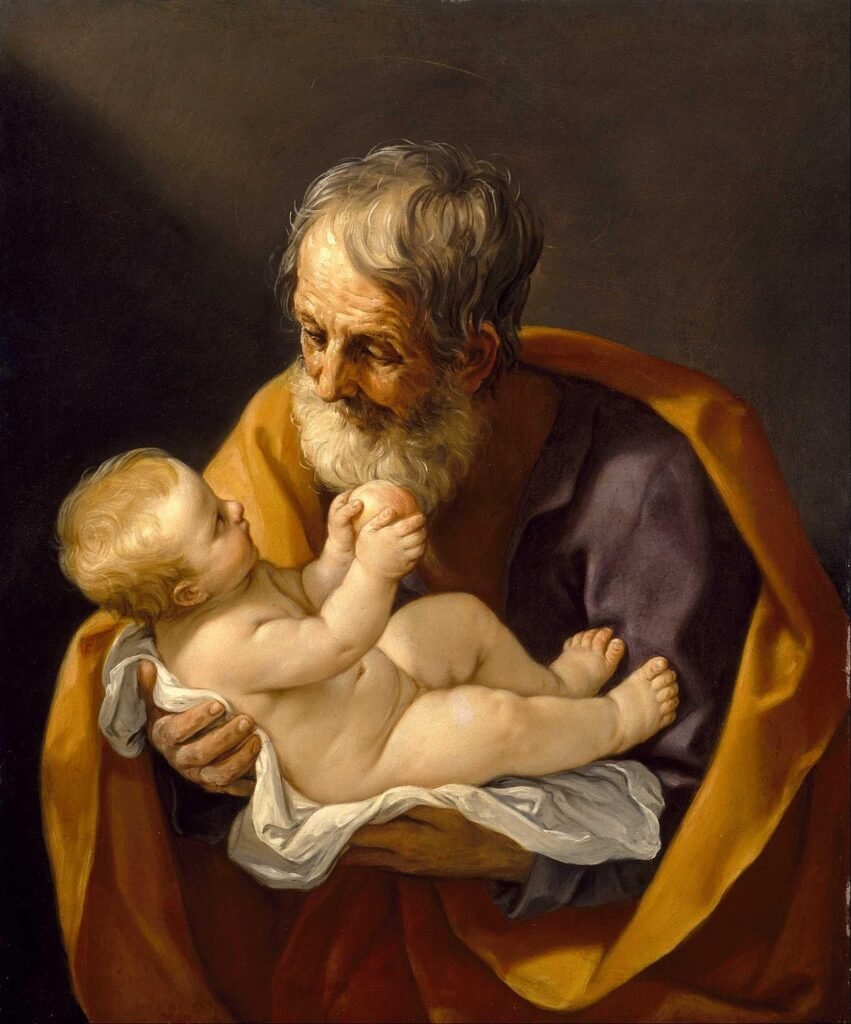Fra Filippo’s resplendent Madonna della Cintola, in the previous post, sent me to a favorite passage in The Waning of the Middle Ages. Johan Huizinga‘s portrait of the linchpins of the medieval world—the ideas that bound together religion, art, and literature—has a few things to say about relics. The significance of them to the culture that embraced them is an integral part of medieval civilization.
The distinctly corporeal conception of the saints was accentuated by the veneration of their relics, not only permitted by the Church but forming an integral part of religion. . . . In the matter of relics the deep and straightforward faith of the Middle Ages was never afraid of disillusionment or profanation through handling holy things coarsely. The spirit of the fifteenth century did not differ much from that of the Umbrian peasants who, about the year 1000, wished to kill Saint Romuald, the hermit, in order to make sure of his precious bones; or of the monks of Fossanuova who, after Saint Thomas of Aquinas had died in their monastery, in their fear of losing the relic, did not shrink from decapitating, boiling and preserving the body.
He continues:
During the lying-in-state of Saint Elizabeth of Hungary, in 1231, a crowd of worshippers came and cut or tore strips of the linen enveloping her face; they cut off her hair, nails, even her nipples. In 1392, King Charles VI of France, on the occasion of a solemn feast, was seen to distribute ribs of his ancestor, Saint Louis. To Pierre d’Ailly and to his uncles Berry and Burgundy he gave entire ribs; to the prelates [he gave] one bone to divide between them, which they proceeded to do after the meal.

• • • • •
Veneration of relics draws its breath from the veneration of saints. Martyrs hold pride of place among the sacred dead. Their status persists from biblical times. That early community we call Christian was a gathering of believing Jews who carried with them reverence for the history of Judaism’s martyrs—lionhearts who died rather than forsake the One God or offer libation to idols. Christian martyrs, like the Maccabees before them, upheld truth against those who hated it. Their relics testify to trust in the psalmist’s words: “Even though I walk through the valley of the shadow of death, I will fear no evil, for You are with me.”
• • • • •
Skepticism toward the cult of relics is neither modern nor secular. It appeared among clerical elites in the late fourth century. St. Jerome (d. 420) was sympathetic to the cult if rightly understood: “We do not worship, we do not adore . . . but we venerate the relics of the martyrs in order the better to adore Him whose martyrs they are.” Scholar that he was, he had little tolerance for popular—”vulgar”—piety. He disdained “superstitious” attachment to the cult of relics encouraged by “the simplicity of laymen, and certainly of religious women.”
• • • • •
In the Middle Ages, the vigor of the relic trade spawned entrepreneurial approaches to the challenges of supply and demand. If a desired artifact was not available for sale, there remained the venerable tradition of relic theft. Creative manufacture and provenance—translationes—played their part. Remember Chaucer’s enterprising Pardoner. He worked the pilgrimage route to Canterbury, hawking fabricated relics (“pigges bones”) to credulous travelers.

Among the most highly coveted relics was Jesus’ foreskin. Medievals cherished it as evidence of the Christ Child’s humanity—both emblem and proof of the Incarnation. The earliest known documented reference to the Holy Prepuce dates from 800 when Charlemagne gifted it to Pope Leo III. Charlemagne claimed that it had been brought to him by an angel. [A contrary tradition claims it was given to him by Byzantium’s Empress Irene of Athens.] Before many were lost or smashed during the Reformation and French Revolution, the number of foreskin relics was impressive. They ranged, depending on records, from some eight to eighteen throughout Europe.
[The pitfalls of using hagiographic material for recovering history are notorious. If the topic interests you, see Furta Sacra, Patrick Geary’s compelling study of relic theft in Middle Ages.]
• • • • •
In the fourteenth century, Saint Bridget of Sweden‘s vision of the foreskin relic and its residence in Rome was taken as confirmation of its authenticity. The fame of it reached its apogee in the mystic marriage of Catherine of Siena. Born some four decades after Bridget (b. 1303), Catherine (b. 1347) inherited belief in the material existence of the Holy Prepuce that had burrowed into the temper of her times.
Visions of betrothal to Christ were not uncommon in the hagiographical biographies of certain other holy women. What distinguishes Catherine’s espousal is the ring—visible only to herself—placed on her ring-finger by Christ. Was it bejeweled? (“. . . gold set with four pearls and a diamond” wrote Herbert Thurston, S.J., scholar of mystical phenomena, in 1952.) Or was it what she herself wrote: that it was made of Jesus’ foreskin, hence an embodied sign of covenant and Communion?
Blessed Raymond of Capua, Catherine’s confessor and biographer, wrote: “She many times admitted to me . . . that she always saw that ring on her finger and that never was there a time she did not perceive it.” [Her ring-finger was kept as relic by the Carthusians of Pontigano; a thumb accompanied her head to the Basilica.]

• • • • •
Familiarity with the corporeality of the saints affected visual imagery. Medieval depictions of St. Joseph often illustrated an irreverence born of too-casual imaginative acquaintance. Huizinger wrote:
Veneration of the saints . . . is subject to the influences of popular fantasy rather than of theology, and they sometimes deprive it of its dignity. The special cult of Saint Joseph towards the end of the Middle Ages is characteristic in this respect. It may be looked upon as the counterpart of the passionate adoration of the Virgin. The curiosity with which Joseph was regarded is a sort of reaction from the fervent cult of Mary. The figure of the Virgin is exalted more and more and Joseph becomes more and more of a caricature. Art portrays him as a clown dressed in rags; as such he appears in the diptych by Melchior Broederlam at Dijon.

The marriage of Joseph and Mary, an object of popular curiosity, made of Joseph a comic type despite official reverence paid him. Even Johann Eck, theologian and adversary of Luther, frowned on homely images of Joseph in church settings: “At least he should not be allowed to cook the porridge, ne ecclesia Dei irrideatur.”
• • • • •
The earliest records of a formal following for Saint Joseph are similar in time to those of the sacred foreskin. Both are said to date from around 800 AD. Broederlam’s depiction of a boorish Joseph matured into Guido Reni‘s tender image some three centuries later. By then, popular renditions of the saint had been rinsed in the flood of Counter Reformation impulses. Reni’s protective Joseph holds the babe with all the dignity due him as the nutritor Domini of ancient devotion. [Note the cloth under the undiapered infant. It is a subtle naturalistic touch that, in its ordinariness, testifies to the humanity of the Christ Child.]

• • • • •
Stories of relics and their migration from one place to another—often accomplished with the complicity of the saint in question—is an absorbing literary genre in its own right. Presumption of saintly collusion was encouraged by the fact that certain relics were generous with miracles in one place but denied them elsewhere.
Ultimately, the cult of the saints and of their relics is a phenomenon greater than the sum of its parts. The broader social context is beautifully explored in Peter Woods’ The Cult of the Saints (1981). Subtitled Its Rise and Function in Latin Christianity, the text is an elegant exploration of the role tombs, relics, shrines, and pilgrimages played in Western development.
For the time being, leave the last word here to Huizinger:
The medieval Church was . . . rather heedless of the danger of a deterioration of the faith caused by popular imagination roaming unchecked in the sphere of hagiology. . . . It is remarkable that the Church, so scrupulous in dogmatic matters, should have been so confiding and indulgent toward those who, sinning out of ignorance, rendered more homage to images than was lawful.


